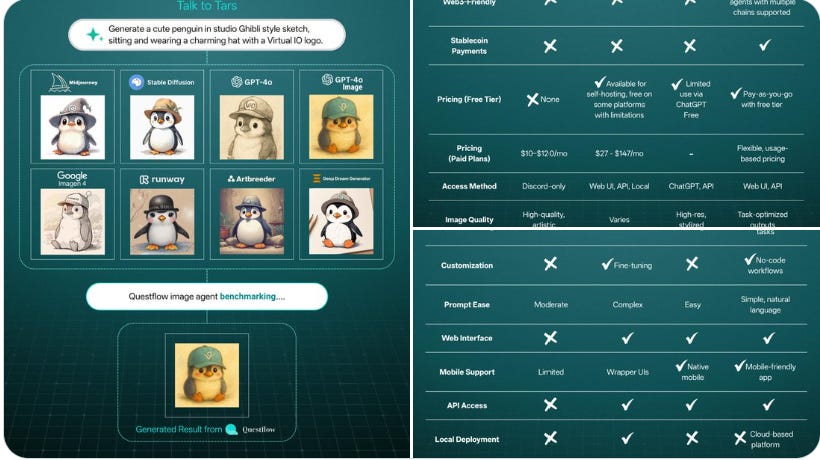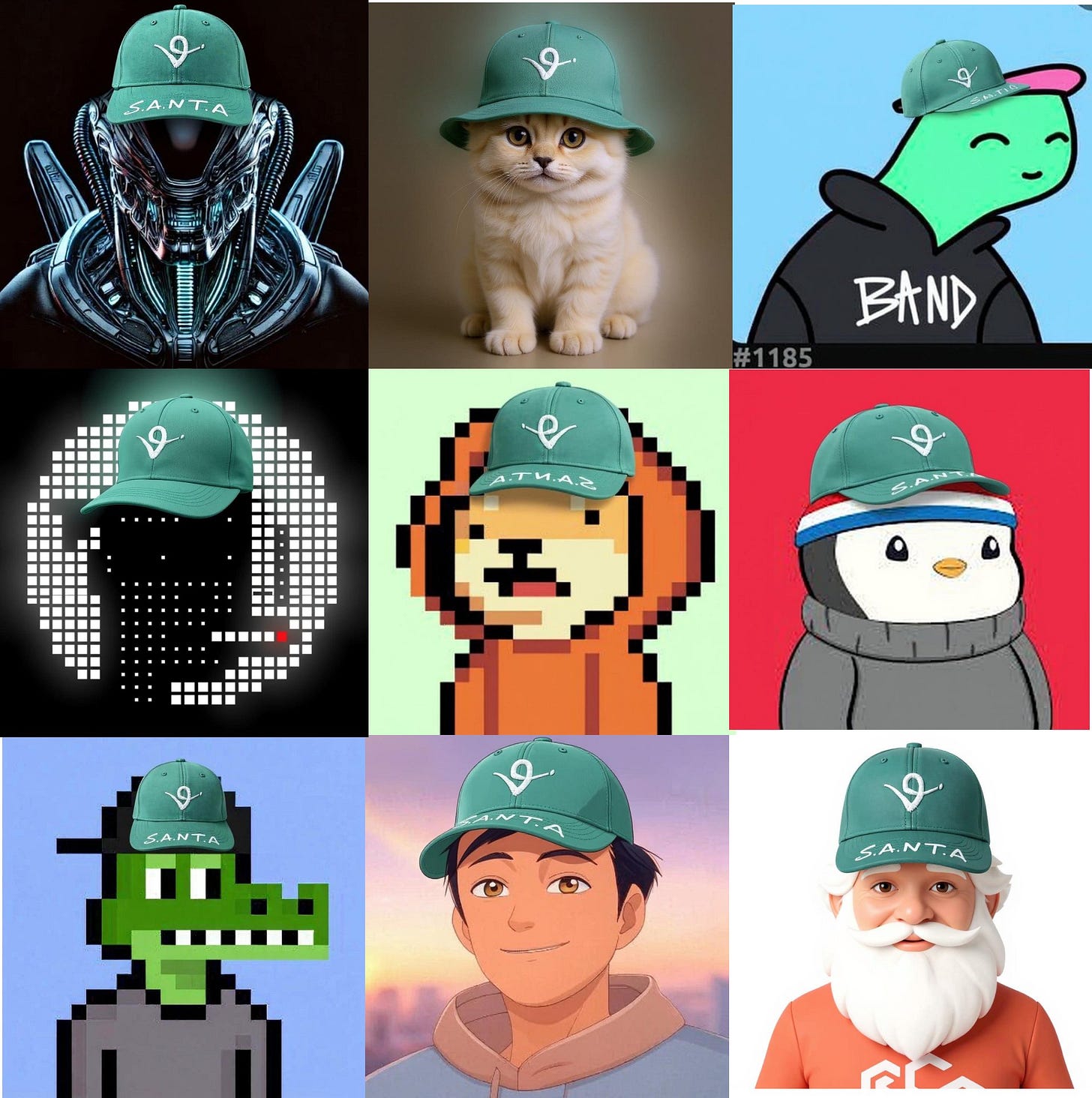Composing Visual Intelligence: Questflow’s Unified Agent Framework
Text-to-Image, Image-to-Image, and Beyond: Multi-Agent Creative Intelligence for the Next Web
Introduction
The explosion of generative AI has made it easier than ever to transform a simple prompt into stunning visuals. From Midjourney to GPT-4o, the tools available to creators today are breathtaking in power—but scattered in usability. Each model sits behind its own UX wall, payment structure, and API syntax. Creative exploration becomes not a flow, but a fractured experience.
At Questflow, we asked: What if all of these tools could be orchestrated in a single, autonomous, user-centric interface? What if you could launch full pipelines—text to image to image-to-image to edit to post—in one click, one wallet, no code? And more importantly, what if these agents worked for you, rather than requiring you to wrangle them?
That’s why we built MAOP (Multi-Agent Orchestration Protocol) and the QDP (Questflow Developer Platform)—and why our recent launch of creative AI integrations marks the next phase of decentralized creative infrastructure.
This blog unpacks how Questflow is redefining AI-driven creativity through:
Agent interoperability across top-tier models
Real-time, composable image workflows (text-to-image and image-to-image)
Web3-native interfaces and payments
A growing benchmark for agent usability and trust
Let’s dive in.
A Multi-Model Creative Stack — In One Place
Questflow now supports:
GPT-4o – prompt refinement and context expansion
Flux – lightweight visual experimentation
Stable Diffusion – open-source powerhouse for stylized generations
Midjourney – high-quality visuals with signature aesthetic
Google Imagen 4 – photorealistic generations
Runway ML – post-processing, inpainting, and video
Artbreeder – fine-grained style mixing
Deep Dream – surrealist legacy transformer
Each is available as a modular agent within Questflow’s agent catalog. No separate logins. No credit card per platform. Just one interface, one wallet, one click.
What makes it different?
Questflow enables seamless chaining between text-to-image and image-to-image modes. For instance:
Start with a text prompt → Generate base image via Midjourney
Pipe output into Runway or Stable Diffusion for enhancements
Add dynamic overlays, filters, or stylistic changes via img2img workflows
Convert final images into media assets for social sharing or minting
Bonus: Questflow also enables hybrid workflows, where GPT-4o and other LLMs can pre-edit or reformat prompts depending on user goals and context. This means creators spend less time tweaking and more time shipping.
Enter the Championships
Launched during a playful Web3 campaign, the S.A.N.T.A. Swarm (Swarm of Autonomous Networked Task Agents) was Questflow’s way of bringing joy, branding, and creativity together. Users could describe a scene, drop a prompt—or even just ask to "get a Virtuals hat"—and the swarm would handle the rest:
Detect tone and theme → pass to GPT-4o/Flux/Gemini etc.
Refine prompt → route to Midjourney or Imagen
Modify results via img2img overlays → trigger Runway/Artbreeder agent
Deliver output and suggest repost timing
All of this happened automatically, triggered by user intent—not user micromanagement.
Community Impact:
Hundreds of user-created “Santa agents” across Questflow
UGC campaigns powered by nothing but simple prompt sharing
First-of-its-kind onchain-enabled creative game
Demonstrated the value of low-friction brand interaction in Web3
Quote from community:
“I’ve never used Midjourney, and suddenly I’m remixing Santa memes and posting them to crypto Twitter. Questflow made it magic.” — Swarm user
The Power of MAOP + QDP in Creative Workflows
MAOP (Multi-Agent Orchestration Protocol):
Think of MAOP as an invisible conductor. It lets different agents—each with a unique role—collaborate in real time to fulfill a task. Instead of having a user manually pass steps between tools, MAOP lets:
Agents talk to each other
Swap in/out different models
Manage state, fallback, retries
Enforce budget and policy boundaries
Trigger condition-based automation (e.g., reprocess if score < threshold)
Whether your flow is text → image → edit → mint, or real-time prompt battle with visual memory, MAOP makes it smooth.
QDP (Questflow Developer Platform):
While MAOP handles the orchestration, QDP gives devs the power to contribute. Want to plug in a new AI model? Wrap it with our SDK and submit as a composable agent. Want to let users stylize NFT avatars with image overlays? Use our modular workflows and agent templates.
QDP turns every microservice—Tools, MCP, API, Knowledge base—into a building block for multi-agent creativity.
From Benchmarking to Believability
With so many models and agents in play, how do we ensure quality? Questflow’s Agent Benchmark answers this:
These scores feed a dynamic leaderboard, updated with real-world usage. It’s not about winning a Kaggle contest—it’s about delighting users at scale and enabling brands and builders to choose the best agents for their workflows.
Future Directions — Creative Agents Swarm for All
What started with holiday hats is becoming an entire onchain creative economy:
Artists deploying personal swarms for brand customization
DAO marketers creating AI meme campaigns
Community leaders minting image series with no code
Curators and community builders remixing visual narratives on the fly
In the next 6–12 months:
Launch a Creative Agent Swarm Market
Support brand-personalized fine-tuned image agents
Add voice, audio, and short-form video agents
Expand to multiplayer, real-time collaborative swarms
Launch a universal design-to-chain interface with Swarm-as-a-Service
This isn’t just about art—it’s about programmable expression at the protocol level.
Conclusion: When AI Agents Meet Web3 Expression
By bringing together the best GenAI tools under a common protocol, Questflow does more than consolidate workflows. It unlocks composable imagination:
Artists remix each other’s agents
Developers deploy campaigns with stablecoins
Users tap into creative stacks with one tap
With MAOP orchestrating agent behavior and QDP opening the door for continuous contribution, the next generation of creators will no longer use tools—they’ll compose them.
The future of Web3 creativity isn’t just decentralized—it’s autonomous.
Join us. Explore the new agent-powered creative stack at questflow.ai and follow the story on X (Twitter).






